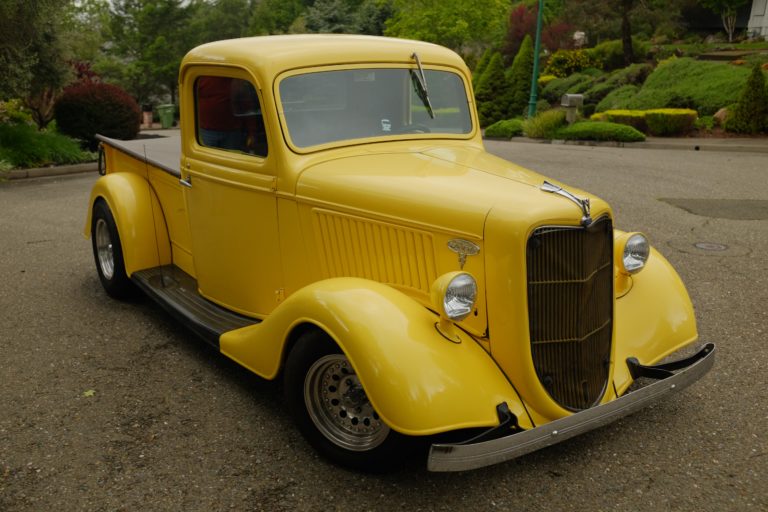By David Wolf
When I built the ’35 Ford pickup I was ably assisted by two old-timers, Sterling Cousins and Ken Dyke—never mind that we are all about the same age. Ken owned the muffler shop in Santa Rosa where most of the hot rod guys hung out. Whenever in the neighborhood I would stop by just to ogle the cars that were there, and I always learned a great deal, as Ken always answered my questions as to how this or that had been done.
I was replacing the V8 that had been in the truck with a seriously powerful new engine that featured fuel injection, which is not too common in hot rods. I got the new engine in, along with a 5-speed transmission, but drive shaft angles were not proper (the angle of the universal joint at the front of the drive shaft must equal that at the rear joint). The problem was the configuration of the floor of the cab.
I left the truck with Ken. I came back a day later and he had fabricated a perfect floor panel from heavy sheet metal that contoured the problem areas and permitted perfect u-joint angles. It was a thing of beauty, with a bright finish and marvelous welds. I complimented Ken and his response was characteristically modest: “David, this is what I do.”
Once I got the new engine into the truck, I was pleased with how everything checked out. Wiring the computer for the injection was no easy matter, but everything seemed correct. Unfortunately, while the engine turned over just fine, it would not start, and would backfire when I stopped the starter. Ken said to get Sterling to look at it.
Sterling Cousins was the service manager for the Chrysler dealership in Santa Rosa and retired fairly young. He has a large house on the west side of town with a huge shop, and room for his collection of odd cars. His favorite is a 1937 Ford police car, complete with lights, siren and paint job. He does not have a lot of patience with some of the old codgers who hung around Ken’s shop, but his intellect is simply stunning. He came to the house. I showed him what was happening. He looked at the installation and was complimentary.
He looked at the basic engine wiring and checked each connection and declared everything looked sound. He then sat down and began to think, and did so for maybe two minutes. Then he walked to the driveway and began walking in circles, mumbling to himself. He stopped short, and asked, “Did the engine that was in previously have a Mallory ignition?” I answered that it did. He asked if there had been a wire running from the Mallory distributor to the starter, and I answered in the affirmative. He said, “Remove it.” I did and he made one change in a wiring connection on the steering column. The engine started right up.
Neither Ken nor Sterling can claim major academic achievements. They know who they are and what they are good at. Their personal standards are very, very high. What they can produce is beautiful, whether tangible—a floor for the truck—or cerebral—deducing what must be the case, from the facts at hand.
Beauty is, indeed, in the eye of the beholder, so if you do some keen beholding, you will see it in places you might not have expected.
David Wolf was educated in Los Angeles public schools, UC Berkeley and Stanford University. His career largely involved leadership positions in California higher education. He has always worked with his hands, and still does in retirement.

